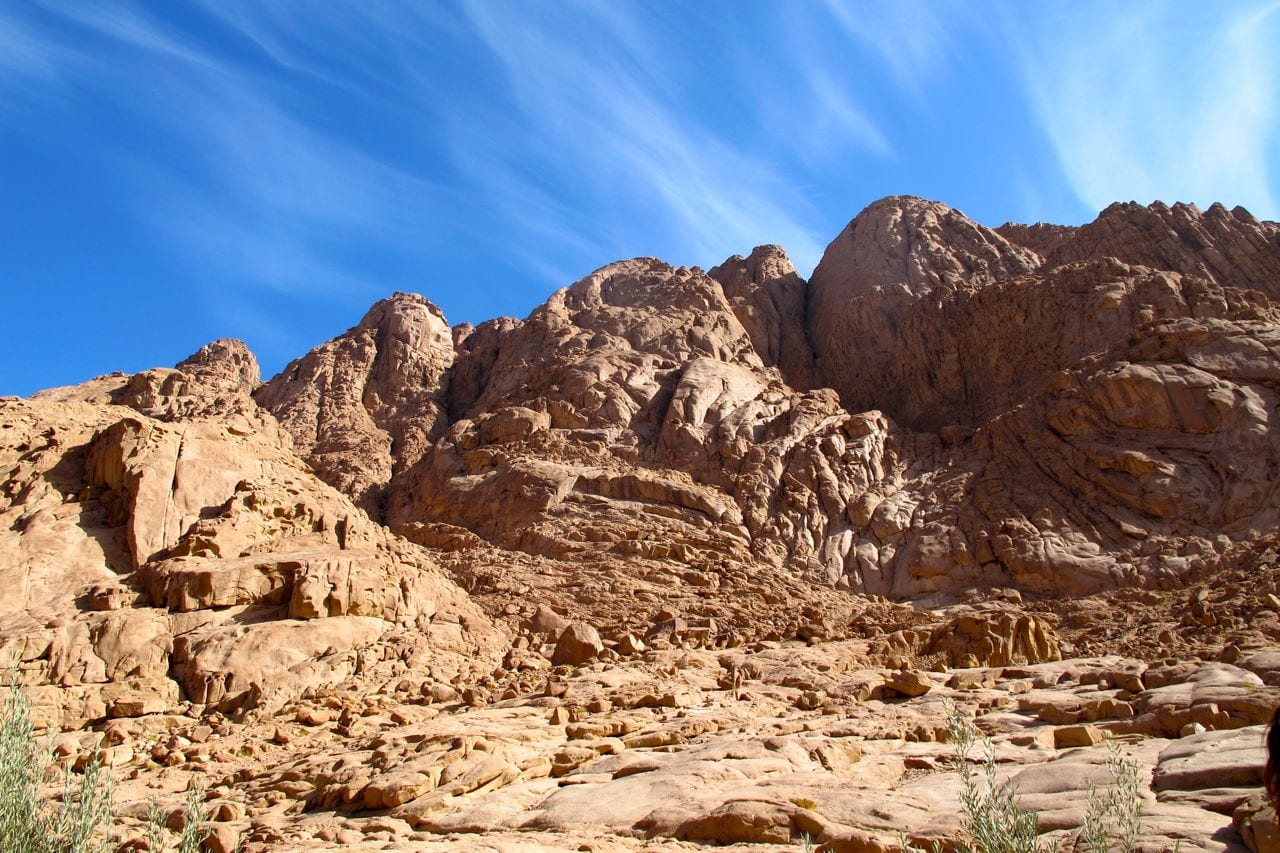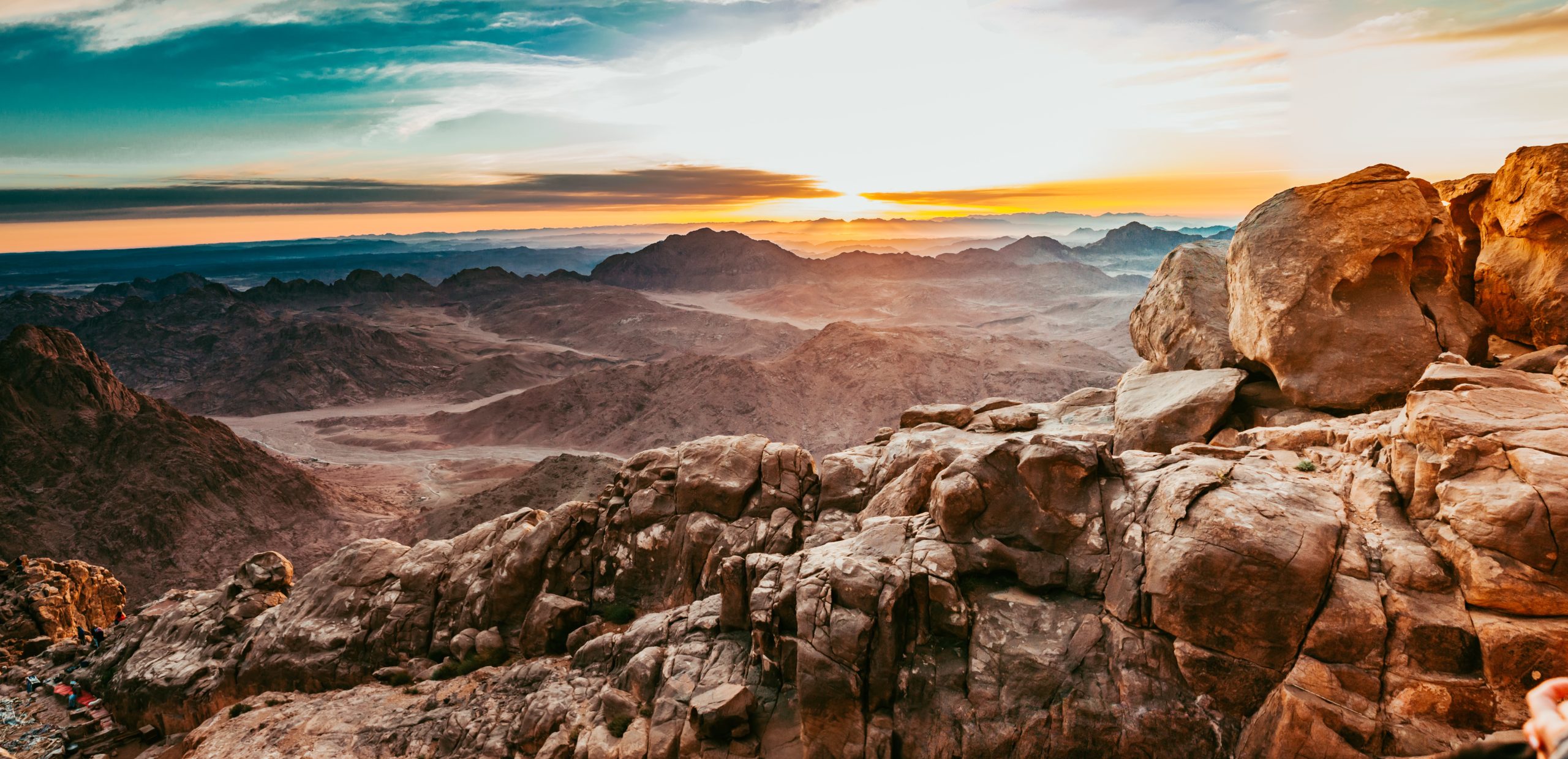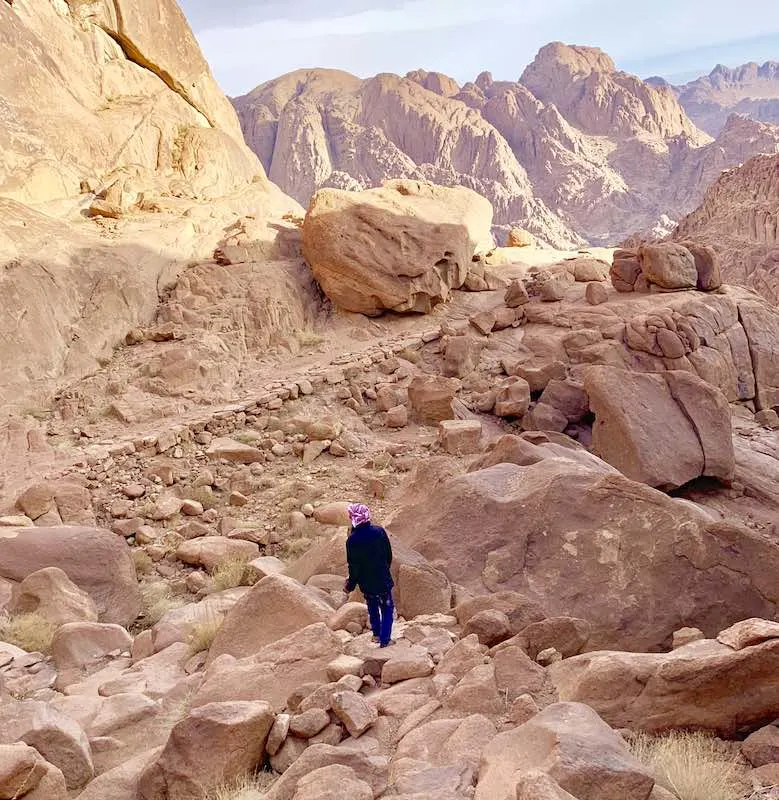Hiking Mount Sinai: A Challenge Worthy of Moses

Hiking Mount Sinai is a challenge that is physically demanding and spiritually rewarding. This awe-inspiring mountain, located in the Sinai Peninsula of Egypt, has long been a pilgrimage site for religious and adventurous travellers. Embarking on this journey is an opportunity to test your endurance and connect with the area's rich history and natural beauty.
An Adventurous Journey
Hiking Mount Sinai is no easy feat, but the breathtaking views and sense of accomplishment make it all worthwhile. The most popular route to the summit is the 3,750 Steps of Penitence, a steep and rocky climb that takes 2 to 3 hours to ascend. The path is well-marked and lit with spotlights, allowing hikers to navigate even in the dark of night.
As you ascend, you'll pass by the impressive St. Catherine's Monastery, one of the oldest working Christian monasteries in the world. This historical landmark adds to the allure of the hike and provides a glimpse into the area's rich cultural heritage.
Once you reach the summit, the view will leave you in awe. From the peak of Mount Sinai, you can witness a breathtaking sunrise or sunset that casts a warm light over the surrounding desert landscape. Being on top of the world is indescribable and worth every step of the journey.
Historical Significance of Mount Sinai
Mount Sinai is not only a natural wonder; it also holds immense historical significance. According to biblical tradition, it is believed to be the mountain where Moses received the Ten Commandments from God. The mountain is revered by Jews, Christians, and Muslims, serving as a symbol of divine revelation and spiritual enlightenment.
The area surrounding Mount Sinai is filled with ancient ruins and archaeological sites that further highlight its historical importance. For example, the nearby St. Catherine's Monastery is home to a vast collection of religious artefacts and ancient manuscripts, including the famous Codex Sinaiticus, one of the oldest copies of the Christian Bible.
Gaining a deeper understanding of the historical and religious significance of Mount Sinai adds an extra layer of meaning to your hiking experience. It is a chance to connect with the past and reflect on the enduring power of faith and spirituality.
Hiking Mount Sinai is a challenge that should be on every adventurer's bucket list. It uniquely combines physical exertion, natural beauty, and historical significance. So, lace up your hiking boots, a leap of faith, and embark on a journey worthy of Moses.
Route Selection
If you're up for a hiking challenge that combines history, spirituality, and breathtaking views, then hiking Mount Sinai should be at the top of your bucket list. Mount Sinai, also known as Jebel Musa, is a sacred mountain in the Sinai Peninsula of Egypt. It is believed to be where Moses received the Ten Commandments from God. Hiking to the summit of Mount Sinai is not only a physical feat but also a spiritual journey.
Different Routes to Hike Mount Sinai
There are several routes to choose from when hiking Mount Sinai, each offering a different experience and level of difficulty. Here are some of the most popular routes:
-
The St. Catherine's Route is the most common and well-known route to hike Mount Sinai. It starts from the Monastery of St. Catherine and follows a well-marked path. The total hiking distance is approximately 7.4 kilometres (4.6 miles), and reaching the summit takes about 2.5 to 3 hours.
-
The Camel Path: As the name suggests, this route allows you to ride a camel for part of the journey. It starts from the Monastery of St. Catherine and includes a steep climb towards the end. The total hiking distance is approximately 3.8 kilometres (2.4 miles), and it takes about 2 to 2.5 hours to reach the summit.
-
The Steps of Repentance: This route is the most challenging and is recommended for experienced hikers. It starts near the Monastery of St. Catherine and consists of 3,750 steps carved into the mountain. The total hiking distance is approximately 4 kilometres (2.5 miles), and it takes about 2 to 3 hours to reach the summit.
Pros and Cons of Each Route
Here is a list of the pros and cons of each route:
| Route | Pros | Cons |
|---|---|---|
| St. Catherine's Route | Well-marked path, offering beautiful views along the way | It can be crowded, especially during peak tourist seasons |
| Camel Path | Opportunity to ride a camel for part of the journey, shorter distance | A steep climb towards the end can be challenging |
| Steps of Repentance | A true physical and mental challenge, fewer crowds | Very steep and strenuous, not suitable for beginners |
No matter your route, hiking Mount Sinai is an unforgettable experience. The stunning sunrise view from the summit is worth every step of the journey. Come prepared with comfortable hiking gear, plenty of water, and a sense of adventure.
So, get ready to follow in the footsteps of Moses and conquer Mount Sinai. It's not just a hike; it's a challenge worthy of legends.

Preparation Tips
Are you up for a challenge? Hiking Mount Sinai is not for the faint of heart, but reaching the summit is truly a rewarding experience. Here are some essential tips to help you prepare for the hike of a lifetime.
Fitness and Training for Hiking Mount Sinai
1. Start training early: Hiking Mount Sinai requires good fitness and endurance. Begin your training routine at least a few months before your planned hike. Aim for a combination of cardiovascular exercises, such as jogging or cycling, and strength training to build stamina and muscle endurance.
2. Gradually increase your distance and elevation: As you train, gradually increase the distance and elevation of your hikes to simulate the conditions you'll encounter on Mount Sinai. This will help condition your body and prepare it for the physical demands of the hike.
3. Practice hiking on uneven terrain: Mount Sinai's trail consists of various terrains, including steep ascents and descents, rocky paths, and loose gravel. Use local hiking trails or nature reserves to practice hiking on similar terrain to build confidence and stability.
4. Focus on cardiovascular endurance: The hike up Mount Sinai can be long and strenuous, lasting several hours. Improve your cardiovascular endurance by incorporating activities like swimming, running, or aerobics into your training routine.
Essential Gear and Equipment
1. Proper hiking boots: Invest in a good pair of hiking boots that provide ankle support and a sturdy grip. They will protect your feet from uneven terrain and provide stability during the climb.
2. Layered clothing: Mount Sinai experiences temperature fluctuations throughout the day, so dressing in layers is essential. Wear breathable and moisture-wicking clothing to stay comfortable during the hike.
3. Backpack: Choose a lightweight and durable backpack to carry essential items such as water, snacks, sunscreen, a map, a compass, and extra layers of clothing. Make sure the backpack fits comfortably and distributes weight evenly.
4. Headlamp or flashlight: For early morning hikes or if you plan to catch the sunrise from the summit, a headlamp or flashlight is essential for visibility in low-light conditions.
5. Water and snacks: Stay hydrated during the hike by carrying an adequate water supply. Pack lightweight, high-energy snacks such as granola bars, trail mix, or dried fruits to keep your energy levels up.
Remember to check the weather forecast before you embark on the hike and be prepared for changing conditions. Hiking Mount Sinai is not only physically demanding but also spiritually rewarding. Take your time, enjoy the stunning views, and embrace the challenge worthy of Moses himself.

Hiking Experience
Scenic Beauty and Natural Wonders Along the Trail
Hiking Mount Sinai is a remarkable experience that offers awe-inspiring natural beauty and stunning scenery. As you make your way up the mountain, you will be surrounded by breathtaking views of rugged landscapes, deep valleys, and majestic rock formations. The trail boasts a diverse range of flora and fauna, including rare and endemic species that add to the enchantment of the journey.
One of the hike's highlights is witnessing the magnificent sunrise from the summit. As the first rays of light appear on the horizon, they illuminate the surrounding mountains and valleys, creating an ethereal atmosphere. It is a sight that will leave you speechless and make the effort of the hike well worth it.
Challenges and Obstacles on the Path
While hiking Mount Sinai is an unforgettable experience, it has its challenges. The trail can be steep and demanding, requiring good fitness and endurance. It is important to come prepared with proper hiking gear, including sturdy boots, a backpack with essentials, and plenty of water to stay hydrated.
The hike can be physically strenuous, especially during the ascent to the summit. The path is well-marked but consists of uneven terrain, rocky steps, and steep sections that may require some scrambling. However, the rewarding views and sense of accomplishment make every step worth it.
It is also essential to know the weather conditions, as the temperature can vary significantly, especially during the early morning hours. It is advisable to check the weather forecast beforehand and dress in layers to adapt to the changing temperatures.
Furthermore, it is important to respect the sacred nature of Mount Sinai. The mountain holds religious significance and is home to numerous historical and religious sites, including St. Catherine's Monastery. Visitors should be mindful of their actions and follow any guidelines or restrictions that are in place to preserve the cultural and natural heritage of the area.
Hiking Mount Sinai offers a rewarding and challenging experience, allowing you to connect with nature and witness breathtaking views that will leave a lasting impression. The journey may be physically demanding, but the sense of accomplishment and the memories created make it an adventure worth undertaking.
So, lace up your hiking boots and embark on this incredible journey worthy of Moses himself.

Summiting Mount Sinai
If you're looking for a hiking challenge steeped in history and offers breathtaking views, summiting Mount Sinai is a journey you won't want to miss. Located in Egypt's Sinai Peninsula, this awe-inspiring mountain holds significant religious and historical importance, as it is believed to be where Moses received the Ten Commandments from God. Embarking on this hike will test your physical endurance and allow you to connect with ancient traditions and spirituality.
Reaching the Top
1. The Hike: The hike to the summit of Mount Sinai is an exhilarating and rewarding experience. The most popular trail is the traditional "Steps of Repentance," which consists of approximately 3,750 steps. The journey can be challenging, especially for novice hikers, as the steep incline requires determination and stamina. However, the breathtaking scenery and sense of accomplishment make every step worthwhile.
2. St. Catherine's Monastery: Along the way to the summit, hikers can visit St. Catherine's Monastery, a UNESCO World Heritage Site. This ancient Byzantine monastery houses a rich collection of religious artefacts and manuscripts, including one of the oldest Christian libraries in the world. Taking a brief detour to explore this historical site adds a layer of cultural significance to the hike.
A Triumph of Perseverance
Standing at the summit of Mount Sinai, you'll feel a sense of triumph and accomplishment. The sweeping panoramic views stretch across the vast desert landscape below. As the sun paints the sky with hues of oranges and pinks, you'll truly appreciate the beauty of this pristine wilderness. It's a moment to reflect on the physical and mental strength it took to reach this point and a reminder of the perseverance needed to overcome any challenge.
Sunrise or Sunset
When planning your hike, one of the most important decisions is whether to witness the sunrise or sunset from the summit. Both options offer their unique magic and atmosphere. Watching the sunrise from the peak of Mount Sinai is a spiritual experience as you witness the desert terrain awaken with the soft glow of the morning light. On the other hand, witnessing the sunset paints the sky with vibrant colours, creating a dramatic and awe-inspiring spectacle. Whichever you choose, it's a moment you'll cherish forever.
Choosing the Perfect Time
To make the most of your Mount Sinai experience, choosing the perfect time to embark on this adventure is vital. The cooler months of spring and autumn (March to May and September to November) offer more comfortable temperatures for hiking, while the summer months (June to August) can be scorching hot. Additionally, planning your hike during weekdays can help avoid crowds more common on weekends and religious holidays.
Overall, hiking Mount Sinai is a challenge worthy of Moses himself. The journey to the summit will test your physical and mental strength, while the panoramic views and spiritual significance will leave a lasting impression. So, lace up your hiking boots, pack plenty of water, and prepare to embark on an unforgettable adventure.

Safety Considerations
Hiking Mount Sinai is a challenging and rewarding adventure that attracts many outdoor enthusiasts. However, it's important to prioritize your safety during this expedition. Here are some health and safety tips before hiking to Mount Sinai.
Health and Safety Tips for Hiking Mount Sinai
-
Physical Preparation: Hiking Mount Sinai requires a good level of physical fitness. Before attempting the hike, engage in regular exercise and build up your stamina. It's also advisable to consult with a healthcare professional to ensure you are in good health for the hike.
-
Proper Gear and Equipment: Wear appropriate clothing and footwear for hiking in rugged terrain. Broken-in hiking boots with good ankle support are essential. Carry a backpack with essentials like a map, compass, flashlight, extra clothing, food, and water.
-
Hydration and Nutrition: Staying hydrated is crucial during the hike. Carry enough water throughout the journey, as there are limited water sources along the trail. Pack high-energy snacks and meals to keep yourself fueled and replenish electrolytes as necessary.
-
Trail Safety: Stay on designated trails and be aware of your surroundings. Mount Sinai's trails can be steep and challenging, so paying attention to your footing and taking breaks when needed is essential. Be mindful of potential hazards and watch out for loose rocks or slippery surfaces.
-
Weather Awareness: Mount Sinai's weather can change rapidly, so be prepared for varying conditions. Check the weather forecast before heading out and watch any updates during your hike. Dress in layers to regulate body temperature and protect against sun exposure.
Weather and Environmental Factors to Consider
-
Temperature: During the day, temperatures can be scorching, so wearing loose, breathable clothing is advisable. As the night falls, temperatures drop significantly, so layering up is crucial. Be prepared for both extremes.
-
Wind and Sandstorms: Mount Sinai is known for its strong winds, especially at higher elevations. Be prepared for gusts of wind and carry a windbreaker jacket. In a sandstorm, seek shelter immediately to protect your eyes and respiratory system.
-
Altitude: As you ascend Mount Sinai, the air becomes thinner, and altitude sickness may occur. It's important to acclimatize yourself by taking breaks and staying hydrated. If you experience severe symptoms such as dizziness, nausea, or difficulty breathing, descend immediately and seek medical assistance.
-
Wildlife: Mount Sinai is home to several animal species, including snakes and scorpions. Be cautious and avoid disturbing or provoking wildlife. Take extra care when walking in the dark to avoid encounters with nocturnal animals.
Remember, hiking Mount Sinai is a significant physical and mental challenge. Being well-prepared, following safety guidelines, and respecting the natural environment is crucial. By doing so, you can conquer this awe-inspiring mountain and enjoy its breathtaking views. Stay safe, and enjoy your expedition to Mount Sinai!
